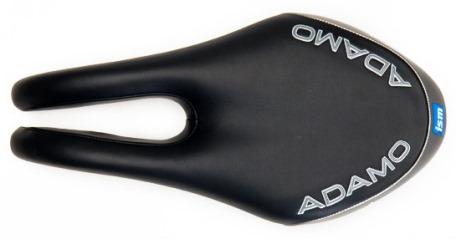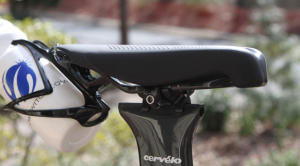This is our review of the new 2013 ISM Attack. We published a review of several other ISM models last year, which you can find HERE.
The Attack is brand new. Well, it’s not ‘new’ in the sense that it has the trademark ISM split nose and unique appearance. However, the overall shape and width are certainly new, as are some general design features. Some say that this is an ISM saddle for road racing. Some say that it can also be used for triathlon? What do we think?
Let's find out.

The widest point of the Attack is narrower than its predecessors. For a comparison, the maximum width of the Attack is 110mm, vs 135mm for the Breakaway. The Attack may also appear to be longer than other ISM saddles, but that’s just an optical illusion. Its overall length exactly matches the Podium, Breakaway, and Prologue saddles at 270mm. It is however, longer than the original Racing model (245mm).
For reference, here is the clif’s notes version of ISM saddles. There are now three main shapes you’re concerned with as a triathlete. Among those shapes, there are different model names, which denote the level of firmness. We will list these shapes below, from firmest to softest in each.
Shape 1 (the original): Racing II, Road

Shape 2: Podium, Breakaway, Prologue

Shape 3: Attack

There is also another shape that I’ll call “1a”, which is the Time Trial. This saddle is very similar to the Racing and Road, but features a downward slope at the very front of the saddle.
Installation and Riding
Is it just the overall width that makes the Attack unique? There is actually a lot more going on than I originally expected. First and foremost, the rails of the Attack are now about 1cm longer than previous saddles. This image shows my Breakaway on the left, and the Attack on the right.

The first question I had was – which direction did the saddle rails grow? Do you get more forward or rearward saddle adjustment?
This image shows my setup before installing the Attack. It is a Breakaway saddle on a zero setback Zipp Service Course seatpost, plugged in to my 78 degree seat-tube-frame.

I opted to align the Attack on the same front adjustment marker. After measuring both saddles about ten times, it appeared that these markers were accurate between saddles, relative to the “nose” of the saddle.

After riding in this configuration several times, I didn’t have to adjust it one bit. I didn’t adjust the height, and I didn’t adjust the fore-aft. This tells me that all of the extra rail length goes toward adjusting your saddle further forward, should you so choose. That was one of my criticisms of the other ISM saddles in the review we published last year (linked at the bottom of this page). When I had a 76-degree tri bike, I wasn’t able to get my Racing II far enough forward without using a setback seatpost flipped forward. With an extra centimeter of forward adjustment on the Attack, I have to think that this issue goes away for almost everyone.
The other part of my test riding that surprised me was this: I found a new favorite saddle. I thought the Breakaway was “it” for me. I thought I was done looking for a better saddle. Sorry - scratch that. I found that that the Attack actually felt as soft as my Breakaway, when the firmness is actually more akin to the tougher Racing and Podium. My only explanation for this is that I had more saddle in the right places, so it just felt friendlier. Perhaps my desire for a softer saddle in the past was actually chasing the wrong thing (padding, not shape).
There are a few things about the Attack that – I think – make it better (at least for me). First, while the maximum width of the saddle is narrower than other ISMs, the “usable width” is greater. This image illustrates what I’m talking about:

As you can see, the overall width is narrower, but the width starts happening sooner. The saddle has broader shoulders than other ISMs. It feels like there is more saddle underneath you.
In addition, while the length of the cutout is shorter than the Podium/Breakaway/Prologue, the depression in the top of the saddle goes much further back.

My unscientific tape-measure-measurement says that the ‘dip’ in the top of the Attack starts about 2cm further back than my Breakaway. If you’re looking to relieve pressure in that, {cough}, region – this could be just what you need.
Also, the width of that depression in the top of the saddle is approximately 1cm wider on the Attack than on the Breakaway.
To sum it up, we have a narrower total width, a wider nose and midsection, a wider and longer cutaway of material, and more forward adjustment range.
Here is a look at both the Breakaway and Attack from the bottom (the black tape on the Breakaway is just my fore-aft adjustment marker):

Does the wide nose make you more likely to rub your thighs on the saddle? In my experience, no. However, I’ve never had that issue with any ISM saddle. I inquired with ISM employee (and Olympic silver medalist, Kona champion, and winner of nearly every triathlon on the planet), Michellie Jones, about the thigh-rub issue that I sometimes read about. According to Jones:
“Almost everyone who complains about thigh rubbing has their saddle too high. With ISM, you always have to lower your saddle at least a few millimeters (or more) compared to other saddles. It’s because you’re resting on your sit bones, and not your other ‘stuff’. The other thing is that many modern bike shorts have a really bulky chamois to help make up for uncomfortable saddles, and this can sometimes cause a little thigh rub with [ISM]. The main thing is seat height, though. Nine times out of ten, lowering the saddle solves the problem.”
Decision Making
How do you know if the Attack is for you? Heck if I know. I thought the Breakaway was the last saddle I’d ever want to ride, and look at me now. Maybe they’ll come out with a new saddle in five years that will make me ditch my now-favorite Attack. I also asked Jones about this question. If someone has never ridden any ISM model before, how do you steer them between saddle shapes? She broke it down in to three main categories:
1. People who sit towards the front of their traditional saddle – put them on a shorter ISM (Racing, Road).
2. People who sit more on the back of the saddle and do a lot of climbing or descending (and want more length) – put them on the Podium/Breakaway/Prologue shape.
3. People who move around a lot (like #2) and want more thigh and hamstring clearance – put them on the Attack.
For #1 or #2, you can pick your firmness level, which is left entirely up to personal preference. That leaves me with a question hanging: Will we see another firmness option in the Attack shape? ISM representatives were not able to comment on their plans, but did mention that this wasn’t the first time they’d heard that question. Take that as a hint or a dodge, but my guess is that they’ll make one if enough of you lovely (demanding) consumers ask for it.

Weight, Price, and Availability
When can you get an ISM Attack? Right now.
How much does it cost? $249.99 ($25 more than most other ISM saddles)
How much does it weigh? Well… we don’t know. ISM does not list weights on their product web pages. I’m personally not a stinker about saddle weight, as comfort is (in my opinion) so much more important. If you look around on the internet, you’ll find that most other titanium-railed ISM saddles weigh in the 300 – 320 gram range. I didn’t have a gram scale available while I was installing this saddle, so I can’t tell you what it weighs. I will say that the construction looks very similar to other ISM saddles, and the rails are the same material… so my guess is that the weight is similar. Perhaps it weighs slightly less due to its narrower shape. The only super light option that I’m aware of in a somewhat similar package is Dash Cycles, although their asking price is much higher at $465 and up.
Our introduction laid out the question – is this a triathlon saddle? A road saddle? My personal opinion is that it doesn’t matter. It’s a saddle for riding bikes. I’ve used ISM saddles on road bikes, tri bikes, mountain bikes, and cyclocross bikes. As of today, all of my bikes (except this one) have the Breakaway on it. Regardless of the bikes’ seat tube angle or riding position, they work for me.
I think we should buy saddles based on features. I don’t care what style of bike you’re riding. Do you want more width in the front of the saddle? What about the rear? Do you want a wide cutout or narrow cutout? Do you want that cutout to start further forward or aft? The list could go on. Let questions such as those be your guide, and then pick your saddle.



